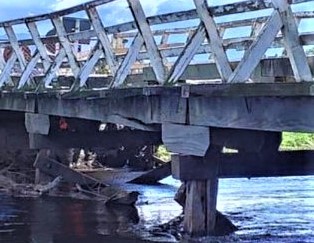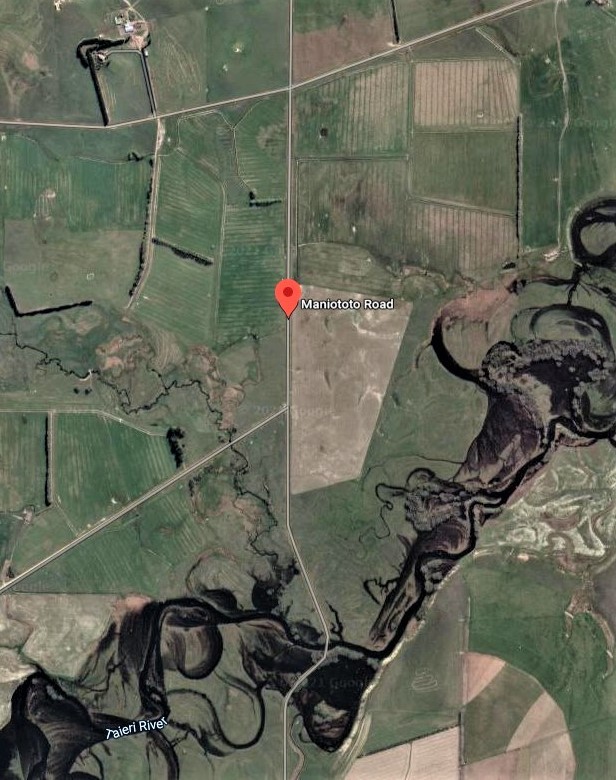A Farm of Two Halves
Jill Herron
26 November 2021, 8:46 PM
 Day to day farming has been “very, very tricky” this year for James Paterson, pictured above at the now closed Halls Bridge on Maniototo Road.
Day to day farming has been “very, very tricky” this year for James Paterson, pictured above at the now closed Halls Bridge on Maniototo Road.Farmers are not short of worries these days – weather woes, bad press, piles of new regulations, shifting markets - so when one farmer’s property got cut in half on top of all that it’s not surprising that his cup of frustration began to runneth over.
Old age is to blame… early this year a pioneer-built timber bridge that has served two generations of the Paterson family and the public for nearly a century, was closed.
The 91-year-old bridge links the two halves of Debbie and James Patersons’ 1300ha sheep and beef property, which is bisected by the upper reaches of the Taieri River near Ranfurly. Halls Bridge has been their daily lifeline for stock crossings, carting needs and frequent vehicle access.

Sizable cracks in the bridge at Halls Ford have prompted its closure to all traffic.
Wear and tear has been showing for a while – 20 to 30 years in fact, James reckons – but an inspection in January revealed the size of the cracks in its tired timbers were getting well beyond a joke and the Central Otago District Council was forced to close the structure to all traffic.
It was one of three in the area closed, the other two suffering damage early that month when widespread flooding occurred, particularly in tributaries of the Taieri.
Like the others, the crossing at Halls Ford had already been weight-restricted for many years, forcing the Patersons to ‘go around’ for any heavy work.
They have been paying a contractor to haul baleage around a 17km detour and stock trucks and the like also have had to go the long way. Services such as fuel and milk tankers passing through what is a public thoroughfare were well used to detouring but when the bridge closed completely this year, mail delivery, health services and daily traffic were also affected.

The Paterson’s homestead, sheepyards and other outbuildings are at the top left of this image. At bottom centre is the Halls Ford area where the closed bridge blocks vehicle access to much of their property.
This part of the Taieri is steep-banked with a peaty, muddy base, Debbie says, so doesn’t easily lend itself to a ford and makes stock crossings treacherous. Replacing the council-owned structure would cost in the hundreds of thousands and reinforcement – as a temporary measure – in the tens of thousands.
“It’s been hugely inconvenient for us, we can’t farm without that bridge and it’s main thoroughfare for people. We’ve looked after it, cleared the willow and fixed broken railings and things but other that than it’s been unmaintained and its at end-of-life stage now,” James says.
Eleven months after the closure, at the end of what has been a hair-tearing and expensive farming year for the couple, the bridge has now been inspected by specialist structural engineers.
James reckons it is “a little bit average” that there had been such a long wait for decisions and that the community or the couple had not been given any idea whether the CODC has funds available to replace the bridge or create a culvert-based crossing.
“If there’s to be no bridge replacement then they{council} need to let communities and locals know so they can make their own plans but don’t leave people on hold. It’s a main throughfare, it’s named after the area, Maniototo Road, it runs from one end to the other of the Maniototo plain. Make a decision and get a bridge in, that’s what I’d like to see happen.”
In October the council reported to the Maniototo Community Board that a combination of Covid-19 related disruptions, a shortage of structural engineers and of roading staff, plus high water levels hampering inspections, had caused the delays.
The Patersons, while disappointed with what they say has been a lack of direct communication had, however, appreciated a visit from Central Otago District mayor Tim Cadogan, who recently travelled out to view the bridge and discuss options.
A CODC spokesperson advised this week that an update is set to be given at the council’s final meeting for 2021 on December 8.
Initial assessments had identified that a deep ford crossing only suitable for farm equipment could be created for around $15,000, according to a council report.
The Patersons, out of desperation, have made their own enquiries for a solution but emphasize that it would be a huge cost to their business and any new crossing would be on private land and not for public use.

The nonagenarian Halls Bridge(centre) remained high and dry as the Wetherburn Creek flooded farmland around it in early January. Image supplied
The family are not the only Maniototo residents eagerly awaiting decisions on bridges. Those around Kyeburn where a concrete wash-over box culvert seems a likely replacement for the now-defunct Scott Lane bridge, also report being frustrated.
Near Paerau no solution appears simple for the closed Linnburn Runs Road bridge which has visible sags and unsupported beams spanning a part of the Taieri too deep for a ford.
All of Central Otago’s 176 bridges are under-going inspection with 23 already weight restricted. A draft district strategy is due for completion late next year. Waka Kotahi(NZTA) help fund the district’s roads and bridges but indications are cost-effective solutions are being favoured due to the high number of older structures now requiring attention.

